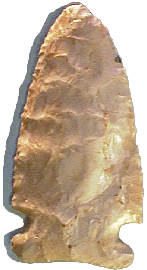

Point Type: BIG
SANDY A.K.A Jakie
Shelter
Also See: Big Sandy
Broad Base, Big
Sandy Contracted Base,
Black Sand, Bolen, Cache River,
Ensor, Fairland, Frio, Godar, Graham Cave, Hemphill, Hickory Ridge, Jakie Stemmed, Kessell, Meadowood, Newton Falls, Osceola, Otter Creek, Pine Tree, Raddatz, Rowan , Savage Cave, St. Albans,
Taylor Side Notched, Uvalde
Location: Midwestern to Southeastern United States
Associated Dates:
11,000 - 3000 B.P. Transitional Paleo to Late Archaic
Morphology: Side
Notched
General Description: The Big Sandy is a small to medium sized, side notched type with early specimens showing heavy basal grinding, serrations, and horizontal flaking on blade faces. The blade is overall triangular in shape and flat with convex to straight blade edges. Fine pressure flaking was used to retouch the blade edges. The basal edge is commonly concave, but occasionally it can be straight. The side notches are usually broad and can range from shallow to deep. The ears are generally squared but can be rounded as described below.
The Big Sandy family of points is composed of three members. There seem to be noticeable differences between early, middle and later types of Big Sandy points. The early types seem to be small versions of the Graham Cave. It is felt that some mis-typed Big Sandy's are actually short versions of the Graham Cave which have been resharpened to near reject stage. Additionally there are variants of the Big Sandy family which are now point types of their own: The Big Sandy Broad Base, Big Sandy Contracted Base, Big Sandy E-Notch and Big Sandy - Leighton Base.
The Big Sandy middle type still has concave bases and some have grinding but the ears of the bases have become more rounded and the use of heat treated cherts and bifacial resharpening is more common. The Big Sandy latter type has much longer stems and prominent, sometimes expanding auriculated ears and are called by some, the Jakie Shelter (named after the Jackie Shelter site in Barry County, Missouri). The Big Sandy type may also be associated with the Frazier point, which could be an unnotched form. Larger Big Sandy specimens were probably used as knives and then with use wear and multiple resharpenings, were transformed into projectile points.
The Big Sandy (a.k.a. Jakie Shelter) and its variants are one of the most common Archaic point types found in the southeastern United States. Big Sandy points occur in highest frequency along the Tennessee River Valley in northern Alabama, Tennessee and Kentucky. They also occur less frequently in Missouri, south-central Indiana, west-central to southern Illinois, southwestern Ohio, northeastern Texas, and into the southeastern states as far south as Florida. The Big Sandy is known under the preferential term known as Otter Creek in the northeast (Ritchie) and the Taylor Side Notched in southeastern Coastal Plain states.
All too often side notched points of various time periods and localities are called Big Sandy points when they are not (see large Also See: above). The Big Sandy is found only in the area noted above and within reasonable distance from it.
Some specimens of the Big Sandy have been carbon dated to 11,000 B.P., but most points are associated with Mid-Archaic times. The age limits for the Big Sandy type are vague with dates ranging from 11,000 to 3,000 B.P. The type was dated in Alabama's Stanfield-Worley Bluff Shelter in the 10,000 - 8,000 B.P. range. The Modoc Rock Shelter in Illinois produced Big Sandy-like points at a depth of 26-27 feet dating between 11,000 - 10,000 B.P. Then at the Hester site in Monroe County, Mississippi the Big Sandy was recovered in strata above Dalton points and below Decatur points giving a date range of 10,000 - 9500 B.P. However Kneberg defined the point as an early to late Archaic type, occurring slightly later than the Eva Basal Notch types and occurring in strata dating from the period 5000 - 3000 B.P. Thus the wide date range attributed to the type.
The average specimen is between 28 mm and 68 mm in length with a width between 18mm and 35 mm and thickness between 4 mm and 8 mm. The type was named by Madeline Kneberg in 1956 for examples she recovered from the Big Sandy site in Henry County, Tennessee.
About the Point Above: The point pictured above, is a magnificent, large Big Sandy specimen made of a wonderfully waxy, two tone white and cream colored glossy flint. It would be considered a "middle type" Big Sandy. The point measures 66 mm in length, 33 mm at the widest point and is 7 mm thick. The width across the ears of the base is 31 mm and the stem is 4.5 mm thick. The blade has fine horizontal flaking across both blade faces and is heavily ground in the basal area with some grinding in the notches. This point was found on the surface near the town of Counce in Hardin County, Tennessee. Catalog Number 68-75-L
References: Baker, Dragoo (b), Edler, Justice, Overstreet, Perino (1), Powell, Puckett (1), Waldorf, Ritchie, Turner & Hester
© Copyright 1997 - 2008 LITHICS-Net WWW.LITHICSNET.COM
Use your Browser's BACK Button to return to the LITHICS-Net Index.